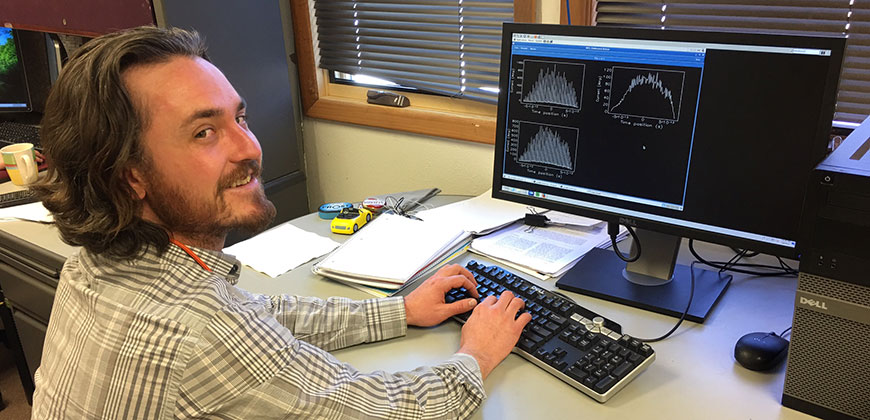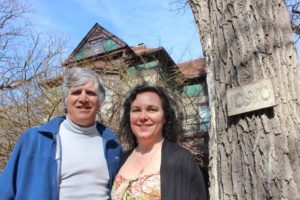Bright lights, big science: Joel Williams helping unleash some of the world’s brightest X-rays
by Anne Manning | February 15, 2017 12:11 PM

Joel Williams, a graduate student in electrical engineering, is spending the next few months at Los Alamos National Laboratory working on the design of an X-ray free-electron laser.
The highest-energy X-rays the world has ever seen could let scientists peer into viruses, study diseases, analyze cracks as they form in hard materials – and that’s just the beginning.
A rare opportunity has landed Colorado State University electrical engineering graduate student Joel Williams on the ground floor of a new wave of X-ray science. Williams is spending the year at New Mexico’s Los Alamos National Laboratory[1], helping to design an X-ray free-electron laser (XFEL) that promises to be among the best in the world.
Thanks to a DOE Office of Science Graduate Student Research award, Williams, who works in the lab of electrical and computer engineering professors Sandra Biedron and Stephen Milton, is working on critical early design features of a planned XFEL. The intense X-ray light source is slated to power a future Los Alamos science facility called MaRIE (Matter-Radiation Interactions in Extreme).[2] Williams’ mentor for the MaRIE project is Los Alamos scientist Bruce Carlsten.
What’s an XFEL?
An X-ray free-electron laser is a very large, complex machine that produces electromagnetic radiation in the invisible X-ray spectrum, in the form of ultra-short, ultra-bright pulses. Part laser and part particle accelerator, there are only a few XFELs in the world, including at Stanford University (LCLS[3]) and in Japan (SPring-8[4]).
The power of XFELs dwarfs that of what is used at the dentist, to put it mildly. XFELs make X-rays that can penetrate and produce images of matter on the scale of atoms. They can peer into the world’s hardest materials, like titanium, or capture movies of nature’s quickest events, like viral replication. The science that could result from XFELs is seemingly endless – from new treatments for cancer, to designing crack-resistant materials for ships and planes.
Los Alamos scientists are charged with improving the existing technology of free-electron lasers, in order to push the limits of X-ray pulses to ever-shorter wavelengths.
Limited space, broad goals
This pushing of limits requires a lot of real estate – for example, a key component of an XFEL is a vacuum structure more than a mile long, called a linear accelerator, where electrons barrel through at near the speed of light. Specially designed magnets aptly called wigglers bounce the beam around, producing X-ray radiation. Such high-energy radiation is dangerous to humans, so a large part of the infrastructure of XFELs is the shielding system that allows experiments to be conducted safely.
The space available for the XFEL within the MaRIE project is limited, so Williams is working on a team charged with shrinking these high-end capabilities into their allotted footprint. Williams is performing the calculations and simulations needed to present possible scenarios of making the XFEL better, and smaller, than any that exist so far.
“We need to reduce the size of the magnetic structures, and produce a very narrow bandwidth light source,” Williams said. “The most difficult part of the project is trying to match all the parameters of what we’re trying to do with the entire machine.”
A chance encounter
For Williams, getting to work on the Los Alamos XFEL is a dream come true – and one that harkens to a time when he knew he loved physics, but couldn’t decide exactly what he wanted to do. During his last year in undergrad at UCLA, where he was a physics and math major, Williams took a particle accelerator class. He liked how it combined mechanical, electrical and other engineering disciplines and applied them to physics problems.
It was a chance encounter that steered Williams to CSU, where he joined the CSU Accelerator Laboratory, led by Biedron and Milton, in 2013.
While finishing school at UCLA, the San Diego native had taken work at a West Hollywood hotel, pondering his next move. He got to chatting with a friendly couple as he was restocking their mini bar. That couple turned out to be Biedron’s parents. He told them he enjoyed the field of accelerators. “It was good I mentioned this specifically, as they then told me about CSU and how [Biedron] was starting a program in accelerator science and engineering there,” said Williams, who at the time knew little about CSU, and had only considered graduate programs in his home state of California. He contacted Biedron, learned more about her and Milton’s vision for the program, and accepted a position in their lab.
Accelerator science at CSU
Williams, and other students like him, have been able to get their hands dirty working on accelerator and laser components at CSU – and it’s this experience that helped Williams land the DOE fellowship.
 [5]
[5]Biedron and Milton have been building CSU’s Accelerator Laboratory from the ground up since 2011, when they had about $4 million of components donated. They also run an experimental laser currently housed at the Thomas Jefferson National Accelerator Facility (“JLab”) for a specific experiment on beam diagnostics. Williams worked on that project at CSU before the device and laser were shipped to JLab.
“We have some very extraordinary hardware here at CSU, including laser systems and particle accelerator components that Joel has been able to work on and learn about,” Biedron said. “It’s imperative also that our students operate around these big facilities, like those at DOE labs, and aren’t just sitting in labs or classrooms. Eleven of the 17 user facilities operated by the DOE for thousands upon thousands of users, for instance, are tied to accelerator systems.”
Now, working at a world-renowned national lab and with plans to come back to CSU to finish his Ph.D., Williams hopes he can make even a small difference in the world of beam science and XFELs.
“My [Los Alamos] mentor [Carlsten] says he wakes up in the morning excited to go to work,” Williams said. “I have to agree with him. This is a really exciting opportunity to able to work on a major project like this.”
- Los Alamos National Laboratory: http://www.lanl.gov/index.php
- MaRIE (Matter-Radiation Interactions in Extreme).: http://www.lanl.gov/science-innovation/science-facilities/marie/index.php
- LCLS: https://portal.slac.stanford.edu/sites/lcls_public/Pages/Default.aspx
- SPring-8: http://www.spring8.or.jp/en/
- [Image]: http://source.colostate.edu/wp-content/uploads/2017/02/BiedronMilton.jpg
Source URL: https://source.colostate.edu/bright-lights-big-science-joel-williams-helping-unleash-worlds-brightest-x-rays/
Copyright ©2024 SOURCE unless otherwise noted.